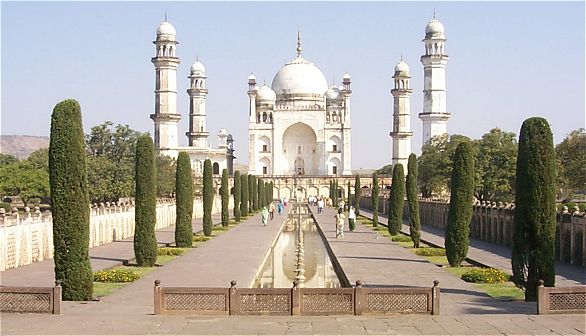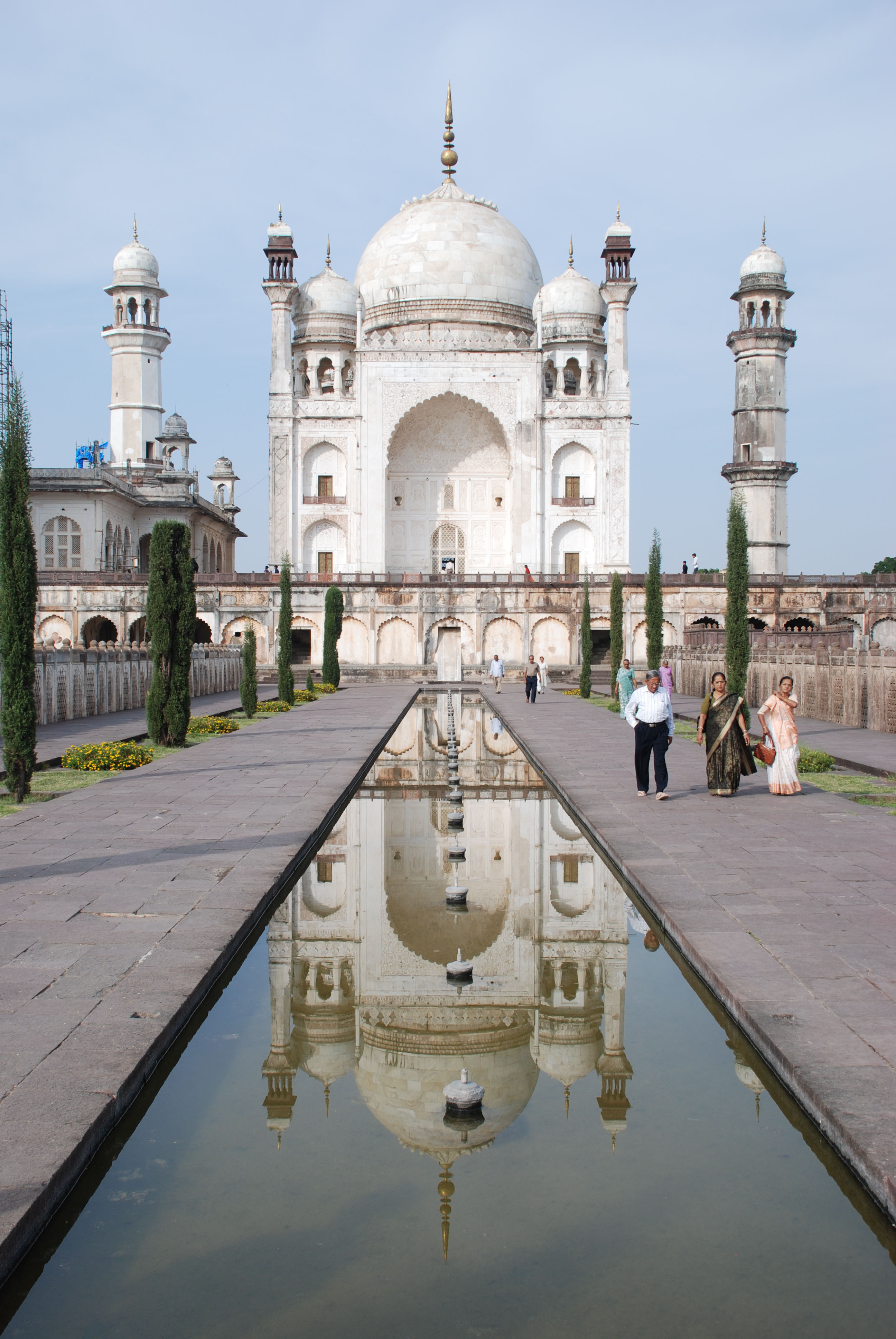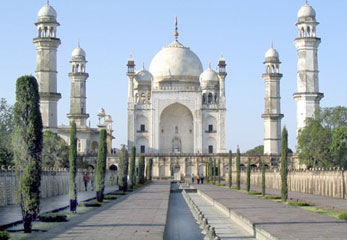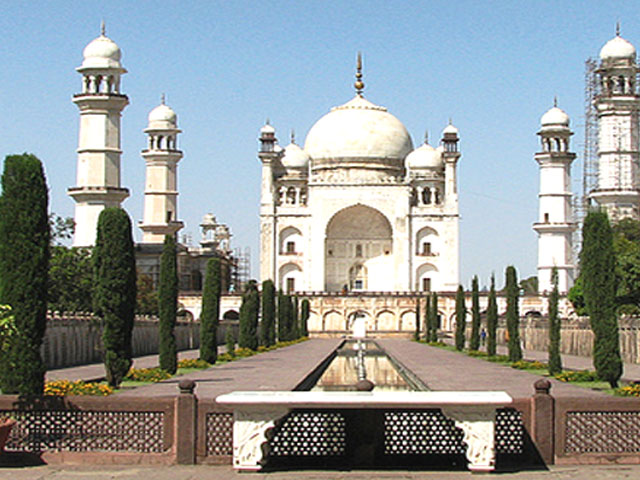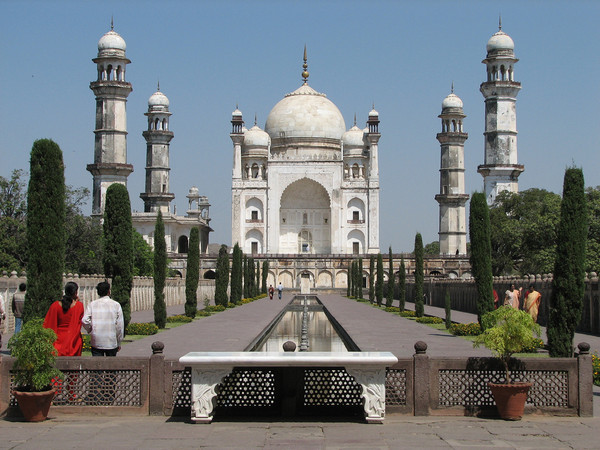Bibi-Ka-Maqbara
The Bibi- Ka Maqbara - ( " grave of the Lady " or " grave of the woman" ) called tomb at Aurangabad is one of the last great mausoleums of the Mughal era in India.
Location
The tomb is located 3 kilometers north of the center of Aurangabad, the government seat of Aurangzeb (reigned 1658-1707 ), the last great Mughal ruler.
History
After his mother Dilras Banu Begum 's death (also called " Rabia Daurana " ), one of the wives of Aurangzeb, took her son Azam Shah - a the decision of his mother in honor - probably with the support of his father, but a lot of time spent on campaigns to build the tomb. The construction time was about ten years ( 1651-1661 ).
Architecture
Torbau
The entrance to the facility will be a grave originally plastered white gate construction with side- beveled accompanying niches. The construction is overall very blocky and simple: Pavilion essays ( chhatris ) and battlements missing - only a few small turrets and a revolving parapet grille adorn the roof. The interior of the gatehouse is but with - richly decorated stucco work - some in color painted.
Park
Behind the gatehouse is a hemmed by walls gardens in the Persian style (Char Bagh ) of about 450 × 275 meters each side that points with its green lawns and plants of all kinds as well as four watercourses on the believers asked the Qur'an promised paradise. The way to the actual tomb is bounded by lateral lattice barriers ( jalis ).
Tomb
The side without major annex buildings erected and thus somewhat blocky -looking mausoleum stands on a platform about 5 feet high of about 40 meters each side. In addition to the thus achieved ' increase ' of the upright structure such platforms serve very practical purposes: for example, the protection against floods during the monsoon season or the protection against roaming animals. Four articulated by dealing balconies and cornices minarets - as usual with Chhatris at the top - are placed in the corners and frame the central bivalve dome. The increased by a drummer and accompanied by four smaller domes and four corner towers outer dome is completely covered with white marble and ends with a circle of marble lotus leaves and a ball bar ( Jamur ). The walls of the mausoleum and the minarets are, however, merely plastered white; Incrustations of precious stones are missing - instead, can be found in the niches with stucco reliefs and vegetable (now badly faded ) floral paintings.
In the area covered by a shallow inner dome top grave space is not - as in the Indian grave architecture otherwise usual - a cenotaph. The bottom of the space is instead largely opened, so that only one handle remains free; limited by an octagonal stone lattice, the view is enabled onto the covered grave of colorful towels in the lower sham sarcophagus grave chamber. The actual burial place, however, lies below the floor level.
Mosque
In the west of the grave construction, but also standing on the platform and between two minarets jammed mosque is an addition of the Nizams of Hyderabad in the early 19th century. This is said that he originally had the plan to dismantle the entire mausoleum and rebuild in Hyderabad.
Importance
The Bibi- Ka Maqbara - is generally considered a scaled-down replica of the Taj Mahal ( Agra ) viewed ( " poor man's Taj "); the construction works because even total cramped and less balanced than his model. The cost was only about 700,000 rupees at a construction period of 10 years - one opposite the Taj Mahal (costs about 32 million rupees / construction about 22 years) vanishingly small amount. Nevertheless, we succeeded Azam Shah, with comparatively small means to create his architect and the craftsmen involved in the construction of a beautiful and dignified tomb.
In contrast to the Taj Mahal where Shah Jahan was buried at the side of his favorite wife, Aurangzeb was after his death - as it was his wish - a very simple grave under the open sky in Khuldabad ( about 27 kilometers northwest of Aurangabad ). Here his son Azam Shah is buried alongside his wife.



